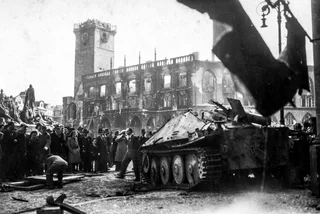An open air exhibition exploring photo censorship has opened on the pedestrian zone of Prague’s Na Příkopě Street. The images can also be viewed online.
The exhibition called Undesired Moments (Nežádoucí okamžiky), which runs through Feb. 14, has more than 20 double-sided panels with 134 photographs, mainly from the Czech News Agency (ČTK) archives. Text on the panels is in both Czech and English.
Some photos have been manipulated to delete people. Other photos were banned by censors for a wide variety of reasons. In still other cases manipulation occurred with misleading captions. The exhibition staged by ČTK highlights methods of censorship, manipulation, and forgery in photojournalism.

“Outdoor exhibitions are one of the few cultural events that people can visit at the moment. We are glad that despite all the difficulties caused by the coronavirus epidemic, we managed to implement and install the exhibition in the center of Prague,” exhibition co-author and ČTK photobank chief Petr Mlch said.
ČTK’s CEO Jiří Majstr, in text on the first panel, explains the importance of the exhibition.
“People believe news photography implicitly. And that is why image manipulation – if someone attempts to do it – is a very dangerous form of manipulation. In my opinion, the main purpose of this exhibition is that we were able to show it. From today’s point of view … photographic news seems a matter of course,” Majstr states.
“Thanks to digital technology, the possibility of manipulation is equally possible. Sometimes it is for harmless entertainment, sometimes the manipulation is admitted and is used, for example, for a satirical effect, as a political or social commentary. … However, it is also easy to do it in an evil, harmful, distorting, censoring, i.e. manipulating way,” he adds.
He points out that the situation has changed from what it had been up to 1990. “Today’s news agency photographers are no longer under pressure not to take photos of this or that person [and] editors are not forced to distort. Exactly the opposite is true. Photojournalists and photo editors are very strictly limited in what they are allowed to do with photography, and any intervention that would change the content of the visual story is, of course, strictly prohibited,” he said.
“Manipulation and censorship go hand and hand with each other. However, while not all manipulation is the result of censorship, all censorship is the product of officially enforced manipulation,” he added.

The displayed photos map the history of Czechoslovakia from 1918 to 1990 using famous as well as less-known photographs that were altered or banned for ideological reasons.
There are also previously unpublished photos of Czechoslovak legionaries, who fought against the Austro-Hungarian monarchy in World War I; photos from the life of people on the eve of World War II and during the Nazi Protectorate of Bohemia and Moravia; original, unretouched portraits of communist functionaries; and some previously banned photos of emigrants, artists and athletes whom the Communist regime found burdensome.
One striking photo shows female students training in the use of gas masks in 1938, when the apprehensions of a war outbreak escalated.
The liberation of Plžen by American troops at the end of World War II was also kept hidden, as the Soviet Union claimed it liberated the entire country. One banned image shows African American soldiers posing with Czech women.

Another photo shows Klement Gottwald, Czechoslovakia's first Communist president, at a table with glasses of alcohol on it, which at the time were censored from the photo.
Perhaps the most famous images show Gottwald addressing the crowd in Old Town Square from a balcony in 1948. In the original, he is next to Slovak politician Vladimír Clementis. Later versions of the photo removed Clementis, who was executed in 1952 after a show trial.
A group shot of Slovak fighters in World War II also saw the number of people reduced and then the order of the people changes to fill in gaps. One of the people removed was Rudolf Slánský, who also was executed after a show trial.
Sometimes the reasons for manipulation were almost funny. In a scene of Soviet troops raising a flag in Berlin, one soldier has two wristwatches. One watch was edited out so it didn’t look like he has stealing watches from dead people.
Later, some photos were edited to remove the birthmark form the head of Soviet leader Mikhail Gorbachev as it was considered unflattering. The practice did not last long, as there were too many photos to keep up.
A photo showing filmmaker Miloš Forman winning an Oscar was banned by the communist censors. Pictures of tennis star Martina Navrátilová were also kept from public view. Both people left Czechoslovkia and found fame in the West.

Some photos were made for export only. Pictures of Nobel Prize–winning poet Jaroslav Seifert were sold to foreign press but not published domestically. Seifert signed the anti-communist Charter 77 before he won the Nobel Prize for Literature.
The last photo in the show is then-Czechoslovak president Václav Havel in 1990. He is seen rather unkempt drinking coffee. His then-wife Olga asked for it to be withdrawn as it seemed undignified. It is now available again, though. Its removal was more of a courtesy and not an official ban.
The exhibition follows up previous exhibitions which ČTK organized in recent years. In 2018, it staged a traveling exhibition marking the centenary of the birth of Czechoslovakia, and in 2019 it prepared an exhibition remembering the communist regime's collapse 30 years ago.












 Reading time: 4 minutes
Reading time: 4 minutes 





























